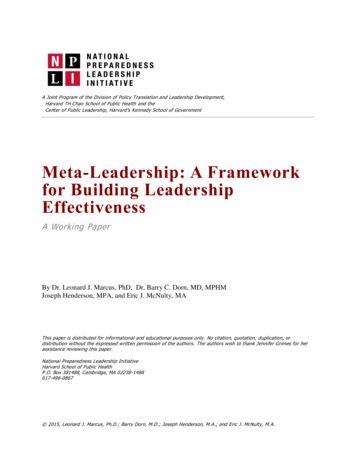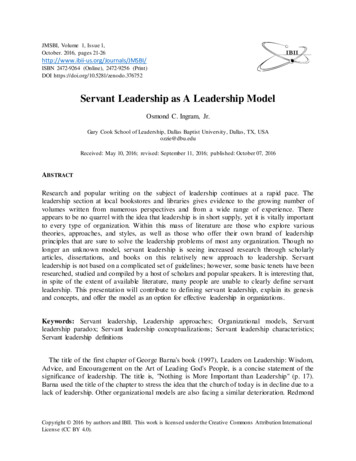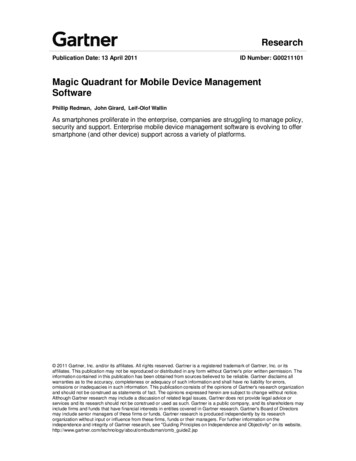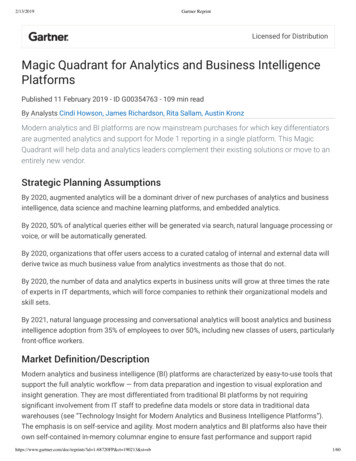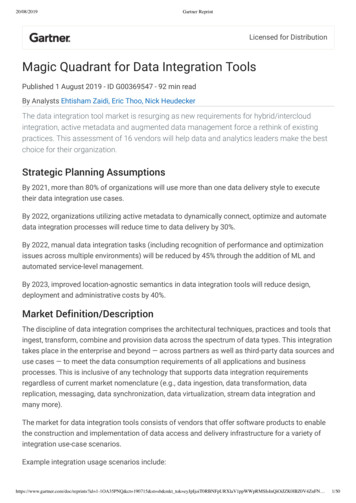
Transcription
Cloud StrategyLeadershipGartner Insights on How andWhy Leaders Must ImplementCloud ComputingEDITED BYDavid Mitchell Smith, Vice President and Gartner Fellow 2017 Gartner, Inc. and/or its affiliates. All rights reserved. Gartner is a registered trademark of Gartner, Inc.or its affiliates. For more information, email info@gartner.com or visit gartner.com.
IntroductionHave you or your CIO expressed any of these concerns?The cloud is notsecure.Pure cloud is theonly option.These are just a few of the myths that surround the world ofcloud computing. In truth, cloud computing has severalvariations and combinations, ranging from no cloud to purecloud, depending on the organization’s needs.The C-suite will look to the CIO to answer questions aboutcloud computing and to help define a strategy to successfullyintegrate cloud into the day-to-day workings of an enterprise.As cloud computing makes its way into its second decade,the options and combinations are expanding to fit eachcompany need.Cloud Strategy LeadershipCompanies canonly use one cloudvendor.No strategy isnecessary to startimplementing cloud.With this book, CIOs can familiarize themselves with varioustypes of cloud options and begin to create a framework tomove their enterprise toward leveraging cloud computing.CIOs will also learn about security in the cloud and whattype of talent is necessary for a successful shift.David Mitchell SmithVice President andGartner Fellow2
ContentsCHAPTER 1CHAPTER 2CHAPTER 3CHAPTER 404131621The Need for CloudStrategySecuring the CloudDeveloping CloudTalentAssess Cloud OptionsCloud Strategy Leadership3
CHAPTER 1The Need forCloud StrategyCloud Strategy Leadership4
The Need for Cloud StrategyEarlier this year, the CIO at a large construction materials companyrealized that by updating its aging IT infrastructure and modernizing thebusiness, the company could expand into other markets and openopportunities for an additional 4 million in annual revenue. Additionally,an updated digitized system would save the company 1 million peryear in supply chain costs.But when the CIO took the idea to the CEO, she was concerned aboutthe risks of moving all the systems to a cloud service, particularlygiven that the company worked with a few highly sensitive governmentcontracts. Additionally, peer CEOs had shared cautionary tales abouttrying to move to cloud, and she was hesitant about the initial investment.The CIO knew the CEO was interested in the potential additionalrevenue and saved costs, and knew he needed to counter the mythsthat accompany mentions of the word “cloud.” So to gain buy-in fromthe CEO and board to move forward, he explained that first they wouldcreate a cloud strategy to focus their cloud efforts on select businessgoals. Next, he explained a framework that would move certain parts ofthe business, such as logistics systems and ordering systems, to thecloud, while ensuring government contracts remained compliant withregulations. As an added bonus, he explained that cloud services wouldenable the company to scale up during the busy summer months, andscale down during the slower winter months. After dispelling myths andproviding a plan, the CIO convinced the CEO to begin the process.Gartner defines cloud computingas a style of computing in whichscalable and elastic IT-enabledcapabilities are delivered as aservice using internet technologies.After a decade of cloud it may come as a surprise that the issue ofcloud computing is still perplexing to many CIOs. Although cloudcomputing is a foundation for digital business, Gartner estimates thatless than one-third of enterprises have a documented cloud strategy.Cloud Strategy Leadership5
The Need for Cloud Strategy“ Having a cloud strategy willenable you to apply its tenetsquickly with fewer delays, thusspeeding the arrival of yourultimate business outcomes.”Donna Scott, Gartner Research Vice Presidentand Distinguished Analyst“A cloud strategy clearly defines the business outcomes you seek, andhow you are going to get there. Having a cloud strategy will enable youto apply its tenets quickly with fewer delays, thus speeding the arrivalof your ultimate business outcomes,” says Donna Scott, research vicepresident and distinguished analyst.As part of the cloud strategy, CIOs need to educate their CEOs andboards of directors about the need to invest in cloud as a style ofcomputing that drives greater speed, agility and innovation through thisdemocratization of IT. In doing so, they should use their digital businessstrategy to justify the investments needed for cloud computing.Digital business requires speed and agility that cloud computingprovides through the use of cloud services that become availableto a broader set of users through a self-service interface. Users“help themselves” to these cloud services, stimulating creativityand innovation.“Organizations that do not have a high-level cloud strategy drivenby their business strategy will significantly increase their risk of failureand wasted investment,” says David Cearley, vice president andGartner Fellow.The cloud strategy must also explore the end goals and what makessense for the enterprise’s mission. Buyer’s remorse is not somethingan organization can afford when adopting a cloud service, says DarylPlummer, vice president and Gartner Fellow. As you would with anyother expensive product or service, start with research. What do youwant out of it? How will you measure the impact and ROI?The key is not to think about it as installing a set of technologies, butinstead, adopt a cloud service from an outcome perspective. What doyou want the cloud to accomplish, and what will the enterprise gainfrom the migration? Keep in mind that simply moving things to thecloud doesn’t automatically make them more efficient or meaningfulto the business. As you review cloud options and begin to create acloud strategy, keep the end goals in the conversation.“ Organizations that do not have ahigh-level cloud strategy drivenby their business strategy willsignificantly increase their risk offailure and wasted investment.”David Cearley, Vice President and Gartner FellowCloud Strategy Leadership6
The Need for Cloud StrategyExplore the cloud spectrumWith so many cloud options, including those that implement partialcloud capabilities, it can be difficult to decide what option is the right onefor each enterprise. It is vital that technology strategic planners selectthe option most aligned with the goals and needs they’ve established.There is value in all approaches to cloud, whether the strategy is purecloud or not, depending on the enterprise and end goals.FIGURE 1: The Cloud Spectrum“Cloud computing represents one of the most misunderstood, yetvaluable, innovations in current IT and business strategies. However, thevalue of cloud computing is reduced by the inability of many end-userorganizations and managed service cloud providers to sort throughtechnology provider cloud options to find the correct mix of cloud andcloud-related capabilities that they need,” says Plummer. “Misalignedexpectations will cause many cloud projects to fail.”Cloud and cloud-related offerings can range from cloud-enablingtechnologies to pure cloud offerings (see Figure 1). This creates aspectrum of capabilities you will need to consider. Whatever optionyou choose, it needs to support intended value propositions.“ Cloud computing represents oneof the most misunderstood, yetvaluable, innovations in current ITand business strategies.”Daryl Plummer, Vice President and Gartner FellowCloud Strategy Leadership7
The Need for Cloud StrategyType 0: Cloud-EnablingType 1: Cloud-InspiredType 2: Pure CloudType 3: Cloud-EnhancedCloud-enabling is not cloudcomputing; however, it doesinclude the technologies thatallow customers to adoptcloud models. This includestechnologies such as visualizationsoftware, physical servers,WAN networks and datacenter colocation.These technologies are closeron the spectrum to a true cloudmodel, but lack several key purecloud attributes such as cloudAPIs and usage-based pricing.The goal for these technologiesis not purity, but rather maximumlevels of consumer control andspecific hosting desires.Pure cloud options are generally,though not always, delivered inthe public cloud over the private.Pure cloud includes examplessuch as Amazon Web Services,Salesforce, Google App Engineand Microsoft Azure.These are cloud offerings builton top of pure public cloudcomputing. This type of offeringassumes that public cloudcomputing already exists andbuilds on top of it to capturevalue from cloud services.These technologies supportcompanies that wish to builda private cloud, and form thebuilding blocks via necessaryarchitecture and physical setup.They should be used to makecloud delivery more reliable,efficient or agile.Companies that select thesetechnologies are less concernedwith the benefits of pure cloudand more concerned with ahigher degree of customizationand control while attainingsome level of virtualization,standardization and automation.Pure cloud enables innovationbrought about by continuousdelivery of new servicecapabilities, and if the businessgoal is maximum agility, purecloud options are a good fit.Examples include streamingvideo services, machine learningplatforms, security as a serviceand GE’s Predix platform, the“social network for machines.”This area is focused on providersgenerating new business growthin cloud-enhanced areas ratherthan traditional cloud areas.They do not provide for truehyperscale, full self-service,ultra-rapid provisioning, orprovider variety and speedof innovation.Cloud Strategy LeadershipThis area of cloud offerings isgrowing rapidly — althoughthe bulk of IT remains in cloudinspired — as many enterprisesmove from “cloud maybe”to “cloud first.”The goal is to discover howenterprises can uniquely benefitfrom public cloud computing.8
The Need for Cloud StrategyA key part of a cloud strategy is a systematic decision framework thatis used to evaluate the benefits and challenges of a cloud approachfor specific application scenarios. Plot a matrix (see Figure 2) that has“Challenges” along its horizontal axis (“high or unmanageable” on the leftto “low and manageable” on the right), and “Benefits” along its verticalaxis (“low or uncertain” at the bottom to “high and clear” at the top).HIGH ANDCLEARCreate a decision frameworkFIGURE 2: Categorizing Cloud Service Options Based onBenefits and ChallengesConsiderPrivateEmbracePublicLOW ORUNCERTAINNow that you have a better idea of what options the cloud spectrumoffers, it’s time to apply this view as you create a cloud strategy, saysCearley. Start by thinking about the different modes, or IT approaches,of your business. In bimodal IT, one approach (Mode 1) focuses onkeeping the business running reliably. The other approach (Mode 2)focuses more on agility, speed and innovation. What is your business’sstrategy? Is it focused on stability or innovation? A cloud strategy mustaddress both modes based on the overall business strategy and thedegree to which the business is focused on driving innovation andaggressively pursuing digital business.AvoidExperimentHIGH ORUNMANAGEABLELOW ANDMANAGEABLEBenefitsThink bimodalChallengesCloud Strategy Leadership9
The Need for Cloud StrategyThen for each cloud application or use-case scenario you’re considering,evaluate and mark the framework with:Potential benefits: How high-priority are the benefits orrewards that cloud could offer? If the business has requesteda customer-facing microsite for a seasonal promotion, cloudbenefits might be rapid time to solution and access toinnovation. Benefits under other scenarios might be costsavings, solutions to capacity problems, or better handling ofworkload imbalances or volatility.Potential risks and challenges: What are the potentialdownsides or dangers to using cloud services? For an insurancecompany considering moving its claims adjustment applicationinto the public cloud, security and regulatory challenges mightbe issues. In other use cases, risks and challenges might bepotential lock-in, integration difficulties or market immaturity.Applications in the upper-right quadrant are the immediate primecandidates for public cloud. Applications in the lower right are candidatesfor public cloud when a company is pursuing a “cloud first” approach,but more cautious companies or those early on their journey to usingcloud may want to wait for these applications.Cloud Strategy LeadershipThis technique will offer a rough outline of where and how to provisionvia the cloud; however, further analysis should follow. This may shiftsome of the parameters and move the dots on the matrix.For example, the availability of risk mitigation options (using encryptionor tokenization to address security concerns) could reduce the riskand have an impact on your overall assessment. Likewise, yourorganization’s experience with cloud computing and having bestpractices to secure, manage, and govern access and usage of cloudservices can help offset risks as your understanding and managementof cloud matures.Applications that land in the upper-left quadrant, where cloud servicebenefits are high and clear but the risks or challenges are also high,may be good candidates for a private cloud approach including eithera managed private cloud hosted by a third party or virtual privatecloud services delivered by public cloud providers. For example,companies that work in markets with government compliancerequirements, such as medical or government contracting, mightprefer to build in-house cloud services.10
The Need for Cloud StrategyDefine guiding principles for cloud adoptionIT leaders must define a set of high-level guiding principles for the idealway for cloud adoption to occur and expectations for associates toconsider, adopt and use cloud services. These principles will be uniqueto each organization, but there are common principles for guidance.Specificall
organizations and managed service cloud providers to sort through technology provider cloud options to find the correct mix of cloud and cloud-related capabilities that they need,” says Plummer. “Misaligned expectations will cause many cloud projects to fail.” Cloud and cloud-related offerings can range from cloud-enabling technologies to pure cloud offerings (see Figure 1). This creates .


